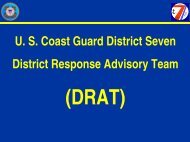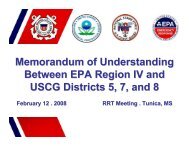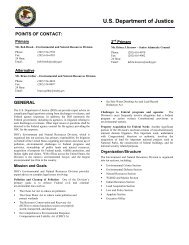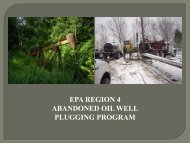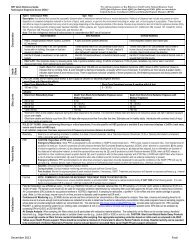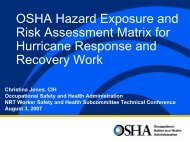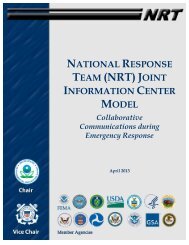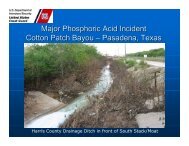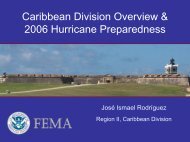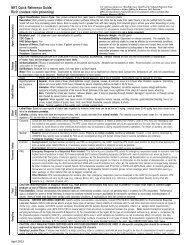USE OF DISPERSANTS - U.S. National Response Team (NRT)
USE OF DISPERSANTS - U.S. National Response Team (NRT)
USE OF DISPERSANTS - U.S. National Response Team (NRT)
- No tags were found...
Create successful ePaper yourself
Turn your PDF publications into a flip-book with our unique Google optimized e-Paper software.
- dispersant composition;- water salinity; and- temperature.Laboratory Testing:One way to measure a dispersant's effectiveness, relative to other dispersants, is through laboratorytesting. The <strong>National</strong> Contingency Plan (NCP) calls for manufacturers to perform a Swirling Flaskeffectiveness test (SWT) prior to listing their dispersant on the Product Schedule. In this test, seawaterand oil are swirled in a flask for twenty minutes. Then, after a 10 minute settling period, a sample ofwater is collected from the bottom of the flask and analyzed for oil content by spectrophotometry. Thefinal "effectiveness" figure quoted in the NCP is derived by averaging the percent of oil dispersed with agiven dispersant and tests with Prudhoe Bay crude and South Louisiana crude oils.In the NCP, EPA adopted a minimum effectiveness result of 45 percent with the SWT for listing aproduct as a dispersant on the Product Schedule. This ruling significantly aids the ability of RRTs toevaluate dispersants. For example, on previous Product Schedule lists of "dispersants", more than halfdid not even attain a 10 percent effectiveness rating. By only listing products that have a 45% or bettereffectiveness rating, OSCs can muster a greater degree of confidence in a product's expectedeffectiveness.It should be emphasized that the results of the Swirling Flask test, or any other laboratory test, do notnecessarily indicate the effectiveness of a dispersant in the field. In fact, the <strong>National</strong> Research Councilconcluded that, "Unfortunately, there is no strong correlation between laboratory and field tests." Thereare simply too many variables that affect effectiveness of a dispersant in the field -- i.e. application rate,type of oil, weather conditions, etc.Visual Monitoring:Another way to assess a dispersant's effectiveness is through visual monitoring of a slick followingdispersant application. Several Regions have adopted procedures for accomplishing this, most notablythe federal Region VI <strong>Response</strong> <strong>Team</strong>. Using their method, observers, during an overflight of theapplication operations, visually observe and record the operations and their impacts on the slick. Theirconclusions of the dispersant's effectiveness are then relayed to the OSC to support further dispersant-usedecision-making.Some caution must also be applied when interpreting visual monitoring results. A recent Workshop,convened by major private and public agencies involved in oil spill operations, concluded that visualmonitoring may not always be a precise indication of a dispersant's effectiveness. For example, somestudies on dispersants show that dispersants may not become effective until several hours afterapplication. One expert in oil spill dispersants writes, "One should certainly not expect a slick todisappear as soon as it is sprayed with dispersant . . .” Other reports from the field indicate that, while adispersant may not appear to be working, it may in fact be inhibiting emulsification, thereby making theoil more dispersible.Another problem with using visual monitoring as a means of estimating dispersant effectiveness is thatsubjective interpretations of what constitutes dispersal can drastically influence results. Although trainingobservers in standardized methods may help alleviate this problem, some level of subjectivity will alwaysbe present with this method. In fact, the <strong>National</strong> Research Council wrote, [concerning visual monitoringat spills of opportunity] "In [some] tests, different observers at the same site reached different conclusionsabout how much of the slick had been dispersed."



